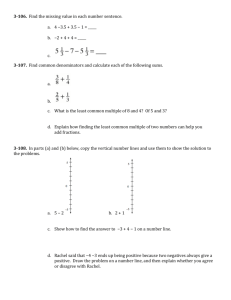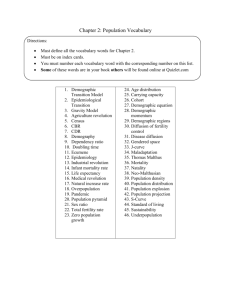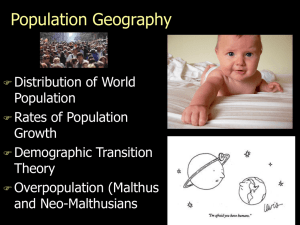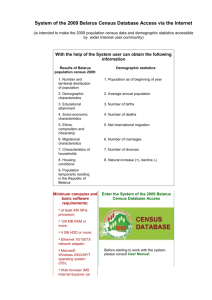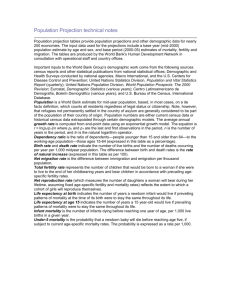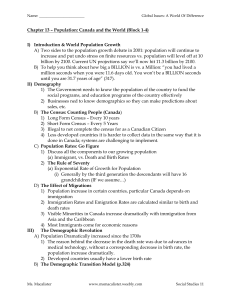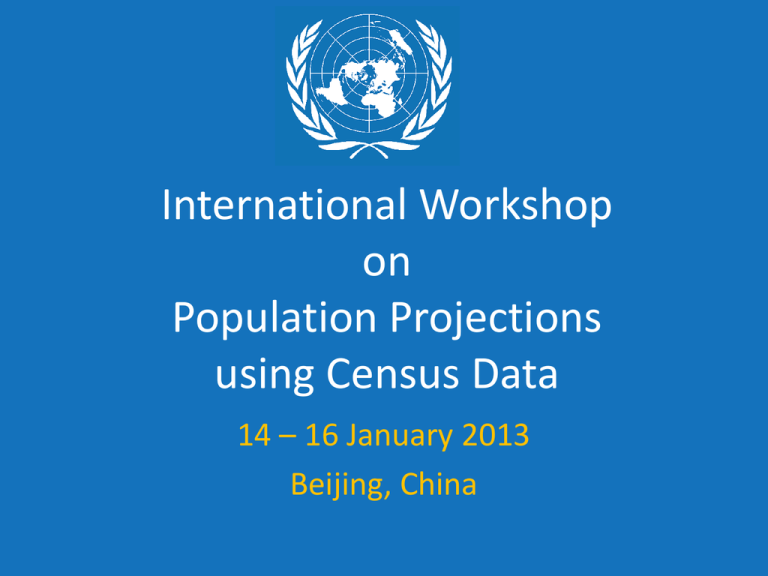
International Workshop
on
Population Projections
using Census Data
14 – 16 January 2013
Beijing, China
Session III:
Establishing the base population
• Detecting errors in data
• Correcting distorted or incomplete data
Detecting Errors in
Age and Sex Distribution Data
• Basic tools
• Graphical analysis
-
• Population pyramids
• Graphical cohort analysis
Focus of the presentation
Population by age and sex
determined by fertility, mortality
and migration, follows fairly
recognizable patterns
• Age and sex ratios
• Summary indices of error in age-sex data
• Whipple’s index
• Myers’ Blended Method
• United Nations Age-sex accuracy index
• Use of stable population theory
• Uses of consecutive censuses
What to Look For at the Evaluation
• Possible data errors in the age-sex structure
• Age misreporting (age heaping and/or age exaggeration)
• Coverage errors – net under- or over-count (by age or
sex)
• Significant discrepancies in age-sex structure due to
extraordinary events
• High migration, war, famine, HIV/AIDS epidemic etc
Collecting Information on
Age and Quality
•
Age - the interval of time between the date of birth and
the date of the census, expressed in completed solar
years
• The date of birth (year, month and day) - more precise
information and is preferred
• Completed age (age at the individual’s last birthday) – less
accurate
•
•
•
•
Misunderstanding: the last, the next or the nearest birthday?
Rounding to nearest age ending in 0 or 5 (age heaping)
Children under 1 - may be reported as 1 year of age
Use of different calendars in the same country– western, Islamic or
Lunar
Basic Graphical Analysis
- Population Pyramid
• Basic procedure for assessing the quality of census data on
age and sex
• Displays the size of population enumerated in each age
group (or cohort) by sex
• The base of the pyramid is mainly determined by the level
of fertility in the population, while how fast it converges to
peak is determined by previous levels of mortality and
fertility
• The levels of migration by age and sex also affect the shape
of the pyramid
Population Pyramid (1)
– High fertility and mortality
Nepal, 1981
85 +
80 - 84
75 - 79
70 - 74
65 - 69
60 - 64
55 - 59
50 - 54
45 - 49
40 - 44
Quick narrowing -> high mortality
35 - 39
30 - 34
25 - 29
20 - 24
15 - 19
10 - 14
5-9
0-4
-1500000
-1000000
Wide base indicates high fertility
-500000
0
Male
Source: United Nations Demographic Yearbook
500000
Female
1000000
1500000
Population Pyramid (2)
– Low Fertility and Mortality
Japan, 2010
100 +
95
90
85
80
75
70
65
60
WWI
WWII
First baby boom
55
50
45
Fire horse year
Second baby
boom
40
35
30
25
20
Low fertility
level
15
10
5
Under 1
-1200000
-700000
-200000
Male
Source: United Nations Demographic Yearbook
300000
Female
800000
Population Pyramid (3)
- Detecting Errors
• Under enumeration of young
children (< age 2)
• Age misreporting errors (heaping)
among adults
• High fertility level
• Smaller population in 20-24 age
group – extraordinary events in
1950-55?
• Smaller males relative to females in
20 – 44 - labor out-migration?
Source: Reproduced using data from U.S. Census
Bureau, Evaluating Censuses of Population and
Housing
Population pyramid (4)
- Detecting Errors
Bhutan, 2005
95+
90
Age heaping? Undercount of children?
85
80
75
70
Qatar, 2010
65
60
55
50
45
40
35
30
25
20
15
10
5
0
-10000
-8000
-6000
-4000
-2000
M ale
0
2000
4000
6000
8000
Female
75 +
70 - 74
65 - 69
60 - 64
55 - 59
50 - 54
45 - 49
40 - 44
35 - 39
30 - 34
25 - 29
20 - 24
15 - 19
10000 10.14
5-9
1-4
-250000
Labour in-migration
Source: United Nations Demographic Yearbook
-200000
-150000
-100000
-50000
Male
Female
0
50000
100000
Creating Population Pyramids
Or, PASEX – Pyramid.xls
Basic Graphical Analysis
- Graphical Cohort Analysis
• Tracking actual cohorts over multiple censuses
• The size of each cohort should decline over each census due
to mortality, if no significant international migration
• The age structure (the lines) for censuses should follow the
same pattern in the absence of census errors
• An important advantage - possible to evaluate the effects of
extraordinary events and other distorting factors by
following actual cohorts over time
Graphical cohort analysis
– Example (1)
• For this analysis we organize
the data by birth cohort
• New cohorts will be added
and older cohorts will be lost
as we progress to later
censuses
• Exclude open-ended age
category
Source: United Nations Demographic Yearbook
Graphical Cohort Analysis
– Example (2)
Source: United Nations Demographic Yearbook
Age Ratios (1)
• In the absence of sharp changes in fertility or mortality,
significant levels of migration or other distorting factors, the
enumerated size of a particular cohort should be
approximately equal to the average size of the immediately
preceding and following cohorts
Age
Population
15 - 19
a
20 - 24
b
25 - 29
c
2b a c
• Significant departures from this “expectation” presence of
census error in the census enumeration or of other factors
Age Ratios (2)
• Age ratio for the age
category x to x+4
• 5ARx = The age ratio for
the age group x to x+4
• 5Px =The enumerated
population in the age
category x to x+4
• 5Px-5 = The enumerated
population in the
adjacent lower age
category
• 5Px+5 = The enumerated
population in the
adjacent higher age
category
5ARx
=
2 * 5P x
5Px-n
PASEX – AGESEX.xls
+ 5Px+n
Age Ratios (3) - Example
Source: United Nations Demographic Yearbook
Age Ratios (4) - Example
Philippines, 2007, single-year
1.4
1.3
1.2
1.1
1
Philippines, 2007, 5-year 0.9
0.8
1.1
0.7
0
1.05
1
0.95
5
10 9
-1
15 4
-1
20 9
-2
25 4
-2
30 9
-3
35 4
-3
40 9
-4
45 4
-4
50 9
-5
55 4
-5
60 9
-6
65 4
-6
70 9
-7
75 4
-7
9
0.9
Source: United Nations Demographic Yearbook
20
40
60
80
100
Sex Ratios (1)
• Sex Ratio =
5Mx / 5Fx
– 5Mx = Number of males enumerated in a specific age
group
– 5Fx = Number of females enumerated in the same age
group
PASEX – AGESEX.xls
Sex Ratios (2)
Sex ratio, Thailand 2000
1.2
Slightly higher mortality among
males in younger ages reverses SR –
migration could also play a role
1.1
1
0.9
In most
societies the
SRB is slightly
over 1.0
0.8
0.7
Considerable female
advantage in mortality
at older ages
Source: United Nations Demographic Yearbook
+
85
10
.1
4
15
-1
9
20
-2
4
25
-2
9
30
-3
4
35
-3
9
40
-4
4
45
-4
9
50
-5
4
55
-5
9
60
-6
4
65
-6
9
70
-7
4
75
-7
9
80
-8
4
-9
5
0
-4
0.6
Sex Ratios (3) – Cohort Analysis
Cohort analysis, sex ratio, China
1.3
1.2
1.1
1
0.9
0.8
0.7
0.6
0.5
0.4
0.3
96
19
99
-1
9
86
19
99
-1
0
76
19
98
-1
0
6
19
7
19
6
0
56
19
96
-1
0
46
19
95
-1
1982
Source: United Nations Demographic Yearbook
0
36
19
94
-1
0
26
19
1990
93
-1
0
1
19
2
19
6
2000
0
0
19
1
19
6
0
9
18
0
19
6
0
Summary indices – Whipple’s Index
• Reflect preference for or avoidance of a particular terminal
digit or of each terminal digit
• Ranges between 100, representing no preference for “0” or
“5” and 500, indicating that only digits “0” and “5” were
reported in the census
• If heaping on terminal digits “0” and “5” is measured;
Index =
(P
(1 / 5) ( P
25
P30 ...... P55 P60 )
23
P24 ....... P60 P61 P62 )
Source: Shryock and Siegel, 1976, Methods and Materials of Demography
100
Whipple`s Index (2)
• If the heaping on terminal digit “0” is measured;
Index=
P30 P40 P50 P60
100
(1 / 10) ( P23 P24 ....... P60 P61 P62 )
• The choice of the range 23 to 62 is standard, but largely
arbitrary. In computing indexes of heaping, ages during
childhood and old age are often excluded because they
are more strongly affected by other types of errors of
reporting than by preference for specific terminal digits
Whipple’s Index (3)
• The index can be summarized through the following
categories:
Value of Whipple’s Index
•
•
•
•
•
Highly accurate data
Fairly accurate data
Approximate data
Rough data
Very rough data
<= 105
105 – 109.9
110 – 124.9
125 – 174.9
>= 175
Whipple’s Index Around the World
Source: United Nations Demographic Yearbook
Improvement Over Time Possible
Summary Indices –
Myers’ Blended Index
• Conceptually similar to Whipple’s index, except that the index
considers preference (or avoidance) of age ending in each of
the digits 0 to 9 in deriving overall age accuracy score
• The theoretical range of Myers’ Index is from 0 to 90, where 0
indicates no age heaping and 90 indicates the extreme case
where all recorded ages end in the same digit
Myers’ Blended Index: Example
Source: United Nations Demographic Yearbook
Myers’ Blended Index: Example
Source: PASEX – SINGAGE.xls
Summary Indices United Nations Age-sex Accuracy Index
Source: United Nations Demographic Yearbook
United Nations Age-sex Accuracy Index
• <20: accurate
• ≥20 and ≤40: inaccurate
• >40: highly inaccurate
PASEX - AGESMTH.xls
A Few Points about Assessment
• Typically the first step in evaluating a census by
demographic methods
• Quick and inexpensive on general quality of data
• Providing some evidence of error on specific segments of the
population
• Limitations
• Can only provide some indication of errors but not on the
magnitude
• Needs to work with other assessment methods
Correcting for Age
Mis-reporting (Smoothing)
• Not modifying the total population - accepting
population in each 10-year age group, then divide into 5year
• The Carrier-Farrag
• Karup-King-Newton
• The Arriaga’s formula (also the first and last group)
Age
Population
20-29
a
30-39
b
40-49
c
Pop (35-39) = f(a, b, c)
Correcting for Age
Mis-reporting (Smoothing)
• Slightly modifying total population - smoothing the 5year age groups
• The United Nations Method
• Strong smoothing – modifying totals based on
consecutive 10-year age groups, then using Arriaga’s for
the 5-year population
Smoothing Example – Lao, 2005
PASEX – AGESMTH.xls
Smoothing Example – China, 2000
PASEX – AGESMTH.xls
A Few Points about Smoothing
•
•
•
•
•
No generalized solution for all populations
Methods produce similar results
Technique used depends on errors in age-sex distribution
Be cautious in using strong smoothing
If only part of population distribution problematic, no
need for smoothing on entire age distribution
Open-age groups
• When terminal age group is too young (younger than 80+
years)
• How to break the terminal age groups?
• Contingency table – national data available for 80+ but not subnational
• Stable population theory – work for any data; needs some
guesses on mortality level
Open-age groups (PASEX – OPAG.xls)
Open-age groups
DPR Korea, 2008
900000
800000
700000
600000
500000
400000
300000
200000
100000
0
45 - 49
50 - 54
55 - 59
60 - 64
Interpolate Male
Reported Male
65 - 69
70 - 74
Interpolate Female
Reported Female
75 - 79
80+
Population Interpolation
• Two censuses data available, need population figure in
between the census dates
• Linear
• Exponential
• PASEX - AGEINT
Population Interpolation
Cambodia
2000000
1800000
1600000
1400000
1200000
1000000
800000
600000
400000
200000
80
+
79
to
74
75
to
69
70
to
64
01/07/2003
65
to
59
60
55
to
54
to
49
03/03/2008
50
45
to
44
to
39
03/03/1998
40
to
34
35
to
29
30
to
24
25
to
19
20
to
14
15
to
9
10
5
to
4
to
1
Un
de
r1
0
Population Shifting
• Moving the population from a given date
(census) to another (mid-year)
– PASEX – MOVEPOP.xls
References
• Arriaga (1994). Population Analysis with Microcomputers, Volume I:
Presentation of Techniques, Bureau of the Census.
• Hobbs, F.B. (2004). Age and Sex Composition. In J. S. Siegel & D. A.
Swanson (Eds.), The methods and materials of demography (2nd
ed., pp. 125–173). Elsevier Academic Press.

